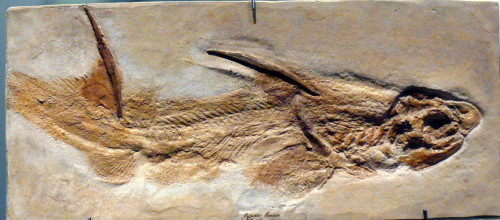Hybodus Fossil specimen from the Museum für Naturkunde in Berlin, Germany Model by Dan Erickson
Hybodus Fossil specimen from the Museum für Naturkunde in Berlin, Germany Model by Dan Erickson and on display at the American Museum of Natural History When: Permian to Cretaceous (260 to 80 million years ago) Where: World Wide What: Hybodus is a very wide spread, both temporally and geographically, fossil shark. I will be upfront here and say that I may be grossly over representing its temporal range, the literature is rather confusing and there have been a number of species going in and out of Hybodus over the years. So you may want to consider this an article on hybodontiform sharks in general, rather than just the one genus. Shark fossils are fairly rare in the fossil record when compared to other fish because sharks do not ossified their skeleton. However, Hybodus and its kin can be identified from fragmentary remains by their distintive teeth (two kinds in their jaws, both flat and pointy) and their ossified dorsal spines. These spines can be easily seen on both the fossil and the model above, they were most likely involved with stabilization of Hybodus as it swam. The relatively few full body specimens preserved complete the picture, showing us that Hybodus was a streamlined shark with a very heavy ribcage compared to most sharks, and that the males had not only ventral claspers, as seen in modern sharks, but also a series of spines on the side of the head - which are depicted above. Hybodontiform sharks were the dominate group of sharks in the Jurassic period, and were even very common in the late Cretaceous after modern sharks had originated and diversified. Studies of this archaic shark clade have shown they were most likely over all slow swimmers, but they could enjoy brief bursts of speed if needed. The diverse teeth forms of hybodont sharks imply they did not just eat fish, but also were able to prey on hard shelled invertebrates. In the shark family tree Hybodontiformes is the first group outside of Neoselachii - the clade that contains all living sharks and rays. -- source link
Tumblr Blog : dailyfossil.tumblr.com
#mesozoic#paleozoic#paleontology#aquatic#marine#fossil#geology#biology#evolution#science

